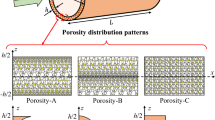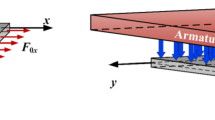Abstract
Parametric study and stability analysis on nonlinear traveling wave vibrations of rotating thin cylindrical shells with simply supported boundary conditions are carried out in the paper. Considering the Coriolis forces as well as the initial hoop tension due to rotation, an infinite-dimensional gyro system model with nonlinearity is established by using Lagrange equations. Based on this model, convergence analysis is performed and the most significant modes dominating the nonlinear behavior are recognized to discretize it to a finite multi-degree system. Then, the periodic solutions of the system are tracked by using harmonic balance method combined with arc length continuation technique. Furthermore, parametric studies are performed and the effects of rotating speed, damping ratio and the amplitude of excitation on the nonlinear dynamic behavior of the shell are investigated. Meanwhile, the Floquet theory is employed to carry out stability analysis of the periodic solutions. The results shown in this paper illustrate the nonlinear dynamic evolution of the traveling wave vibration for rotating thin cylindrical shells.













Similar content being viewed by others
References
Saito, T., Endo, M.: Vibration of finite length, rotating cylindrical-shells. J. Sound Vib. 107(1), 17–28 (1986). https://doi.org/10.1016/0022-460x(86)90279-8
Huang, S.C., Hsu, B.S.: Resonant phenomena of a rotating cylindrical-shell subjected to a harmonic moving load. J. Sound Vib. 136(2), 215–228 (1990). https://doi.org/10.1016/0022-460x(90)90852-Q
Lam, K.Y., Loy, C.T.: Influence of boundary conditions for a thin laminated rotating cylindrical shell. Compos. Struct. 41(3–4), 215–228 (1998). https://doi.org/10.1016/S0263-8223(98)00012-9
Jafari, A.A., Bagheri, M.: Free vibration of rotating ring stiffened cylindrical shells with non-uniform stiffener distribution. J. Sound Vib. 296(1–2), 353–367 (2006). https://doi.org/10.1016/j.jsv.2006.03.001
Sun, S., Chu, S., Cao, D.: Vibration characteristics of thin rotating cylindrical shells with various boundary conditions. J. Sound Vib. 331(18), 4170–4186 (2012). https://doi.org/10.1016/j.jsv.2012.04.018
Sun, S., Cao, D., Han, Q.: Vibration studies of rotating cylindrical shells with arbitrary edges using characteristic orthogonal polynomials in the Rayleigh–Ritz method. Int. J. Mech. Sci. 68, 180–189 (2013). https://doi.org/10.1016/j.ijmecsci.2013.01.013
Qin, Z.Y., Chu, F.L., Zu, J.: Free vibrations of cylindrical shells with arbitrary boundary conditions: a comparison study. Int. J. Mech. Sci. 133, 91–99 (2017). https://doi.org/10.1016/j.ijmecsci.2017.08.012
Qin, Z.Y., Yang, Z.B., Zu, J., Chu, F.L.: Free vibration analysis of rotating cylindrical shells coupled with moderately thick annular plates. Int. J. Mech. Sci. 142, 127–139 (2018). https://doi.org/10.1016/j.ijmecsci.2018.04.044
Qin, Z.Y., Pang, X.J., Safaei, B., Chu, F.L.: Free vibration analysis of rotating functionally graded CNT reinforced composite cylindrical shells with arbitrary boundary conditions. Compos. Struct. 220, 847–860 (2019). https://doi.org/10.1016/j.compstruct.2019.04.046
Qin, Z.Y., Safaei, B., Pang, X.J., Chu, F.L.: Traveling wave analysis of rotating functionally graded graphene platelet reinforced nanocomposite cylindrical shells with general boundary conditions. Results Phys (2019). https://doi.org/10.1016/j.rinp.2019.102752
Amabili, M., Pellicano, F., Paidoussis, M.P.: Non-linear dynamics and stability of circular cylindrical shells containing flowing fluid. Part I: Stability. J. Sound Vib. 225(4), 655–699 (1999). https://doi.org/10.1006/jsvi.1999.2255
Amabili, M., Pellicano, F., Paidoussis, M.P.: Non-linear dynamics and stability of circular cylindrical shells containing flowing fluid, part II: large-amplitude vibrations without flow. J. Sound Vib. 228(5), 1103–1124 (1999). https://doi.org/10.1006/jsvi.1999.2476
Amabili, M., Pellicano, F., Paidoussis, M.P.: Non-linear dynamics and stability of circular cylindrical shells containing flowing fluid. Part III: truncation effect without flow and experiments. J. Sound Vib. 237(4), 617–640 (2000). https://doi.org/10.1006/jsvi.2000.3071
Amabili, M., Pellicano, F., Paidoussis, M.P.: Non-linear dynamics and stability of circular cylindrical shells containing flowing fluid. Part IV: large-amplitude vibrations with flow. J Sound Vib. 237(4), 641–666 (2000). https://doi.org/10.1006/jsvi.2000.3070
Amabili, M.: Theory and experiments for large-amplitude vibrations of empty and fluid-filled circular cylindrical shells with imperfections. J. Sound Vib. 262(4), 921–975 (2003). https://doi.org/10.1016/S0022-460x(02)01051-9
Amabili, M., Balasubramanian, P., Ferrari, G.: Travelling wave and non-stationary response in nonlinear vibrations of water-filled circular cylindrical shells: experiments and simulations. J. Sound Vib. 381, 220–245 (2016). https://doi.org/10.1016/j.jsv.2016.06.026
Amabili, M.: Nonlinear vibrations and stability of shells and plates. Cambridge University Press, New York (2008)
Alijani, F., Amabili, M.: Non-linear vibrations of shells: a literature review from 2003 to 2013. Int. J. Non-Linear Mech. 58, 233–257 (2014). https://doi.org/10.1016/j.ijnonlinmec.2013.09.012
Bich, D.H., Nguyen, N.X.: Nonlinear vibration of functionally graded circular cylindrical shells based on improved donnell equations. J. Sound Vib. 331(25), 5488–5501 (2012). https://doi.org/10.1016/j.jsv.2012.07.024
Du, C.C., Li, Y.H., Jin, X.S.: Nonlinear forced vibration of functionally graded cylindrical thin shells. Thin-Walled Struct. 78, 26–36 (2014). https://doi.org/10.1016/j.tws.2013.12.010
Jafari, A.A., Khalili, S.M.R., Tavakolian, M.: Nonlinear vibration of functionally graded cylindrical shells embedded with a piezoelectric layer. Thin-Walled Struct. 79, 8–15 (2014). https://doi.org/10.1016/j.tws.2014.01.030
Breslavsky, I.D., Amabili, M., Legrand, M.: Static and Dynamic Behavior of Circular Cylindrical Shell Made of Hyperelastic Arterial Material. J. Appl. Mech. Trans. ASME 83(5), 051002 (2016). https://doi.org/10.1115/1.4032549
Sofiyev, A.H., Hui, D., Haciyev, V.C., Erdem, H., Yuan, G.Q., Schnack, E., Guldal, V.: The nonlinear vibration of orthotropic functionally graded cylindrical shells surrounded by an elastic foundation within first order shear deformation theory. Compos. Part B-Eng. 116, 170–185 (2017). https://doi.org/10.1016/j.compositesb.2017.02.006
Sheng, G.G., Wang, X.: The dynamic stability and nonlinear vibration analysis of stiffened functionally graded cylindrical shells. Appl. Math. Model. 56, 389–403 (2018). https://doi.org/10.1016/j.apm.2017.12.021
Li, C.F., Li, P.Y., Zhong, B.F., Wen, B.C.: Geometrically nonlinear vibration of laminated composite cylindrical thin shells with non-continuous elastic boundary conditions. Nonlinear Dyn. 95(3), 1903–1921 (2019). https://doi.org/10.1007/s11071-018-4667-2
Li, C.F., Zhong, B.F., Shen, Z.C., Zhang, J.R.: Modeling and nonlinear vibration characteristics analysis of symmetrically 3-layer composite thin circular cylindrical shells with arbitrary boundary conditions. Thin-Walled Struct. 142, 311–321 (2019). https://doi.org/10.1016/j.tws.2019.05.014
Wu, Z.H., Zhang, Y.M., Yao, G.: Nonlinear forced vibration of functionally graded carbon nanotube reinforced composite circular cylindrical shells. Acta Mech. 231, 2497–2519 (2020). https://doi.org/10.1007/s00707-020-02650-6
Yadav, A., Amabili, M., Panda, S.K., Dey, T.: Non-linear vibration response of functionally graded circular cylindrical shells subjected to thermo-mechanical loading. Compos. Struct. 229, 111430 (2019). https://doi.org/10.1016/j.compstruct.2019.111430
Wang, Y.Q., Guo, X.H., Chang, H.H., Li, H.Y.: Nonlinear dynamic response of rotating circular cylindrical shells with precession of vibrating shape-Part I: numerical solution. Int. J. Mech. Sci. 52(9), 1217–1224 (2010). https://doi.org/10.1016/j.ijmecsci.2010.05.008
Wang, Y.Q., Guo, X.H., Chang, H.H., Li, H.Y.: Nonlinear dynamic response of rotating circular cylindrical shells with precession of vibrating shape-Part II: approximate analytical solution. Int. J. Mech. Sci. 52(9), 1208–1216 (2010). https://doi.org/10.1016/j.ijmecsci.2010.05.007
Wang, Y.Q.: Nonlinear vibration of a rotating laminated composite circular cylindrical shell: traveling wave vibration. Nonlinear Dyn. 77(4), 1693–1707 (2014). https://doi.org/10.1007/s11071-014-1410-5
Liu, Y.Q., Chu, F.L.: Nonlinear vibrations of rotating thin circular cylindrical shell. Nonlinear Dyn. 67(2), 1467–1479 (2012). https://doi.org/10.1007/s11071-011-0082-7
Liu, T., Zhang, W., Mao, J.J., Zheng, Y.: Nonlinear breathing vibrations of eccentric rotating composite laminated circular cylindrical shell subjected to temperature, rotating speed and external excitations. Mech. Syst. Signal Process. 127, 463–498 (2019). https://doi.org/10.1016/j.ymssp.2019.02.061
Sun, S., Liu, L., Cao, D.: Nonlinear travelling wave vibrations of a rotating thin cylindrical shell. J. Sound Vib. 431, 122–136 (2018). https://doi.org/10.1016/j.jsv.2018.05.042
Amabili, M.: A comparison of shell theories for large-amplitude vibrations of circular cylindrical shells: Lagrangian approach. J. Sound Vib. 264(5), 1091–1125 (2003). https://doi.org/10.1016/S0022-460X(02)01385-8
Amabili, M.: Nonlinear vibrations and stability of laminated shells using a modified first-order shear deformation theory. Eur. J. Mech. A Solids 68, 75–87 (2018). https://doi.org/10.1016/j.euromechsol.2017.11.005
Dey, T., Ramachandra, L.: Non-linear vibration analysis of laminated composite circular cylindrical shells. Compos. Struct. 163, 89–100 (2017)
Zhang, Z.Y., Chen, Y.S.: Harmonic balance method with alternating frequency/time domain technique for nonlinear dynamical system with fractional exponential. Appl. Math. Mech. Engl. 35(4), 423–436 (2014). https://doi.org/10.1007/s10483-014-1802-9
Han, Q.K., Qin, Z.Y., Zhao, J.S., Chu, F.L.: Parametric instability of cylindrical thin shell with periodic rotating speeds. Int. J. Non-Linear Mech. 57, 201–207 (2013). https://doi.org/10.1016/j.ijnonlinmec.2013.08.002
Chen, J.C., Babcock, C.D.: Nonlinear vibration of cylindrical shells. AIAA J 13(7), 868–876 (1975). https://doi.org/10.2514/3.60462
Acknowledgements
The authors are grateful to the National Natural Science Foundation of China (Grant Nos. 11802129 and 11902184), Shandong Provincial Natural Science Foundation of China (Grant No. ZR2020QA039), and the Fundamental Research Funds of Shandong University for financial support in this study.
Author information
Authors and Affiliations
Corresponding author
Ethics declarations
Conflict of interest
The authors declare that they have no conflict of interest.
Additional information
Publisher's Note
Springer Nature remains neutral with regard to jurisdictional claims in published maps and institutional affiliations.
Appendices
Appendix A
\({\mathbf{c}}_{\lambda } \left( {\lambda = u,v,w} \right)\), and \({\mathbf{H}}_{i} \left( {i = 1,2, \ldots ,18} \right)\) are given by the following:
Appendix B
\({\mathbf{N}}_{u}\),\({\mathbf{N}}_{v}\) and \({\mathbf{N}}_{w}\) are given by the following:
, where
Appendix C
\({\overline{\mathbf{H}}}_{i} \;(i = 1,2, \ldots ,18)\) are given by the following:
\({\overline{\mathbf{N}}}_{\lambda }^{{}} \;\left( {\lambda = u,v,w} \right)\) are given by the following:
, where
Rights and permissions
About this article
Cite this article
Sun, S., Liu, L. Parametric study and stability analysis on nonlinear traveling wave vibrations of rotating thin cylindrical shells. Arch Appl Mech 91, 2833–2851 (2021). https://doi.org/10.1007/s00419-021-01934-0
Received:
Accepted:
Published:
Issue Date:
DOI: https://doi.org/10.1007/s00419-021-01934-0




